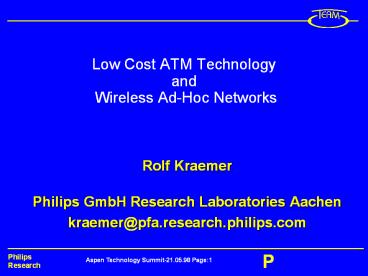Low Cost ATM Technology and Wireless AdHoc Networks - PowerPoint PPT Presentation
Title:
Low Cost ATM Technology and Wireless AdHoc Networks
Description:
Phone. VCR. Teletainment. Gateway. Camera. Speech. Recognizer ... Phone. PC. Light. Control. In Home Digital Network. Teletainment. Gateway. DVD. VCR. Camera ... – PowerPoint PPT presentation
Number of Views:66
Avg rating:3.0/5.0
Title: Low Cost ATM Technology and Wireless AdHoc Networks
1
Low Cost ATM Technology and Wireless Ad-Hoc
Networks
- Rolf Kraemer
- Philips GmbH Research Laboratories Aachen
- kraemer_at_pfa.research.philips.com
P
Philips Research
Aspen Technology Summit-21.05.98 Page1
2
Content
- Vision of an In Home Digital Network
- End to End View
- Embedded ATM Switching for Low Cost Networks
- Functional Switch Decomposition
- Single Chip Approach
- Distributed Software System
- Wireless ATM as extension of Embedded Switching
- Ad-Hoc W-ATM-LAN for Low Cost Broadband IHDN
3
Vision of an IN-Home Network
4
Vision of an IN-Home Network
5
Broadband Access Network
InternetServer
BroadcastTV-Server
VODServer
6
End to End Service Chain
HFC
xDSL
PON
LMDS/MMDS
7
Embedded Switching System Requirements
- Scalability of System Size
- Linear Scalability of Cost with Number of Ports
- No Cost Offset
- Scalability of Service Architecture
- Decentralised Signalling and Switch Control
- Graceful Degradation Behaviour in Case of Faults
8
Functional Partitioning 1/3
- Observations
- The Port Function is becoming increasingly
complex (z.B. by ABR) - Traditional Switch Concepts have too little
Flexibility to support additional new services
(e.g. Processor Speed problems) - Switches are optimised on Throughput and not on
Network operation
9
Functional Partitioning 2/3
Two main decisions have to be taken
Which Basic-Component have to be taken
Which connection topology is best suited for the
basic component
10
Functional Partitioning 3/3
System on Silicon decision
Each Switch Component is a Mini-Switch with all
necessary parts
11
Sample Device Connections
12
Modular structure of basic component
NW1 in
Central Cell Memory
NW2 in
User Network
User Network
UNI in
DMA/AAL
Trl-RAM
PI-bus control
PI-Bus
Bus-IO
RISC-CPU
Local Bus
13
CMC-155 Chip
Size 144 mm2 Transistors 1.98106 Memory 20
0 kb Frequency 20MHz Pins 208 Technology 0.5
?m Supply Voltage 3.3 V Current 0.4 A
14
Distributed Switch Software
15
Intelligent Cabling
16
In Flight Entertainment
Game-Server
Office-Server
Ring Interconnection
VOD-Server
VOD-Server
Ring Interconnection
In-Seat-PCs
17
CMC-Roadmap
Functionality
New Arch
Time
CMC Corporate Multimedia Communication PRO
embedded Processor NIC embedded SAR functions
18
Relation between UMTS and Wireless-ATM
19
Standard Basestation Approach
BSC
CellHand-Over
ATMRadioPort
ATMRadioPort
ATMRadioPort
ATMRadioPort
CellHand-Over
20
WATM-Protocol Stack
User
Control
ATM Adaptation Layer
Wireless Control
ATM Network Layer
Data Link Control
Data Link Control
Standard ATMPhysical Layer
Medium Access Control
Medium Access Control
Phy High Speed Radio
Phy High Speed Radio
21
Distributed Basestation Approach
ATM-UNI
Transceiver
Transceiver
Transceiver
Transceiver
Transceiver
ATMRadioPort
ATMRadioPort
ATMRadioPort
22
CMC-Chip with MAC Support
Central Cell Memory
NW1 in
NW1 out
User Network
User Network
NW2 in
NW2 out
POL
Trl.
Medium-Access (C-MAC)
Radio Interface
DMA/AAL
Trl/POL-RAM
S-MAC-CPU
PI-bus control
PI-Bus
RISC-CPU
23
Wireless ATM Ad-Hoc Scenario
WATMTerminal
WATMTA
ATM
W UNI
WATMTerminal
Ad-HocEnabledWATMTA
ATM
M NNI
ATM
W UNI
24
CMC-Chip with AD-Hoc MAC Support
Central Cell Memory
User Network
Medium-Access (C-MAC)
POL/Shapeing
Radio Interface
Ext. DMA/AAL
S-MAC-CPU
PI-bus control
PI-Bus
Bus-IO
RISC-CPU
Control-Interface/ Interface to MT
25
Conclusion
- Low Cost ATM is not only feasible but already
available (CMC concept) - The distributed CMC-Concept allows the extension
to WATM - The building block approach of the CMC concept
supports the stepwise extension towards full
AD-HOC WATM systems - A first CMC based WATM demonstrator has been
implemented (10Mb/s) - First application will be in the office
environment - The final goal to support IHDN is in reach



























![[AD Hoc Networks] PowerPoint PPT Presentation](https://s3.amazonaws.com/images.powershow.com/8371435.th0.jpg?_=20161231113)



